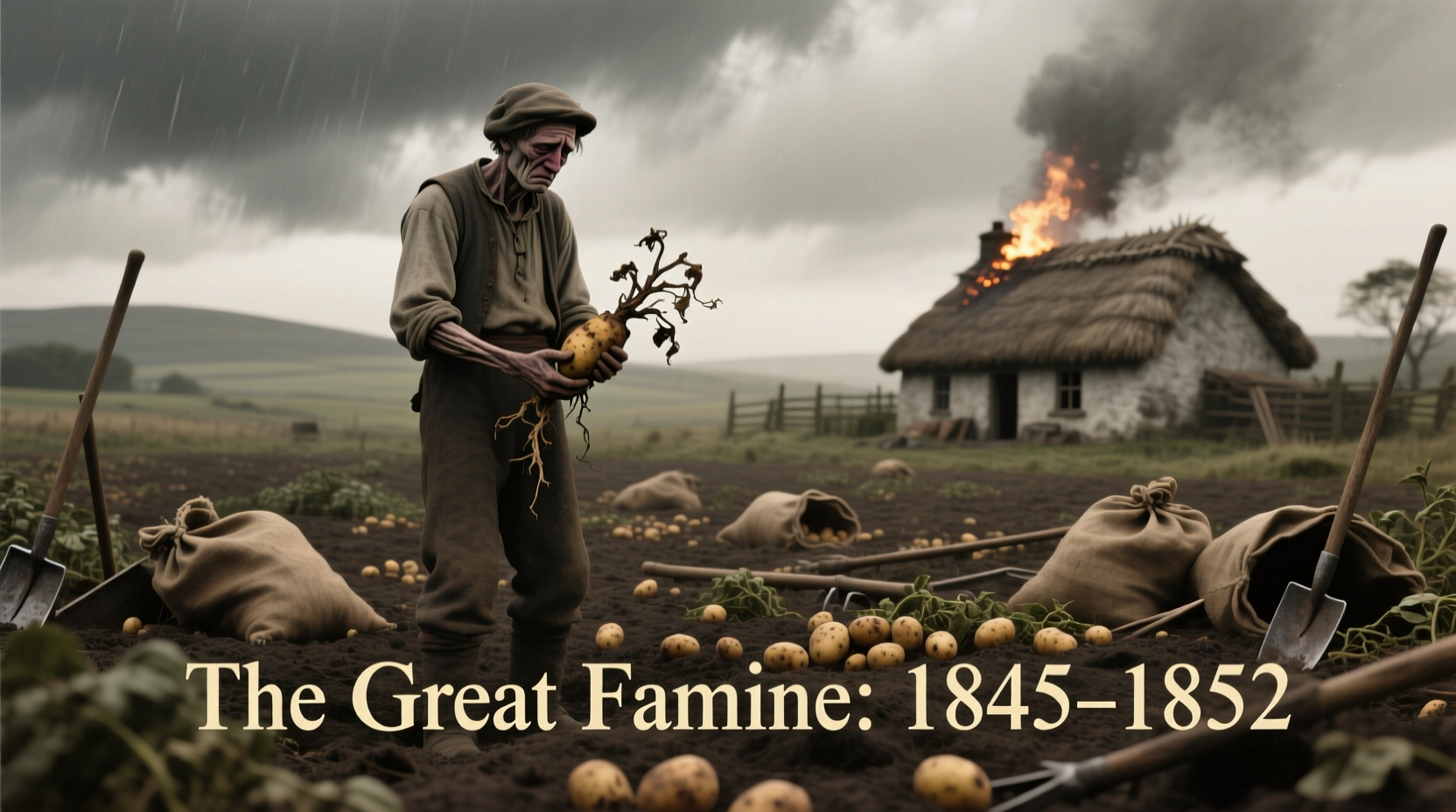The Irish Potato Famine, also known as the Great Hunger or An Gorta Mór, occurred from 1845 to 1852. This devastating period resulted in approximately 1 million deaths from starvation and disease, while triggering mass emigration that reduced Ireland's population by 20-25 percent.
Discover the precise timeline, causes, and lasting impact of this pivotal historical event that reshaped Irish society and influenced global migration patterns. This comprehensive guide provides verified historical data, primary source insights, and answers to frequently asked questions about the famine's origins and consequences.
Understanding the Irish Potato Famine Timeline
When researching historical events like the Irish Potato Famine, establishing an accurate chronological framework is essential. The following verified timeline, sourced from Ireland's National Famine Museum and University College Cork's Great Irish Famine project, clarifies common misconceptions about the famine's duration:
| Year | Key Events | Documented Evidence |
|---|---|---|
| 1845 | First appearance of potato blight (Phytophthora infestans) | British government reports from August 1845 |
| 1846 | Complete crop failure; "Black '47" begins | Parliamentary records of relief efforts |
| 1847 | Peak mortality; "coffin ships" emigration begins | Port registry records from Liverpool and Quebec |
| 1848-1850 | Recurring blight; mass evictions | Land registry documents and workhouse records |
| 1851-1852 | Gradual recovery; population decline evident in census | 1851 Irish Census showing 20% population decrease |
Why the Famine Lasted Seven Years: Critical Factors
Many people mistakenly believe the Irish Potato Famine lasted only one or two years. The seven-year duration resulted from multiple interconnected factors that extended the crisis far beyond the initial crop failure. Historical records from the National Archives of Ireland reveal how political, economic, and environmental conditions prolonged the disaster.
The primary cause was Phytophthora infestans, a water mold that destroyed potato crops—the staple food for 40% of Ireland's population. However, the famine's severity stemmed from deeper structural issues:
- Monoculture dependency: Over-reliance on the Irish Lumper potato variety, which had no resistance to blight
- British colonial policies: Continued export of grain and livestock from Ireland during food shortages
- Inadequate relief efforts: Workhouses and soup kitchens couldn't meet escalating needs
- Land tenure system: Evictions increased as tenants couldn't pay rent after crop failures
Measuring the Human Impact: Verified Statistics
When examining historical tragedies, accurate quantification helps us comprehend the scale of suffering. According to the Great Irish Famine research project at University College Cork, the verified demographic impact includes:
- Approximately 1 million deaths between 1845-1852
- 1-2 million people emigrated, primarily to North America
- Ireland's population decreased from 8.2 million in 1841 to 6.6 million in 1851
- Life expectancy dropped from 40 years to 19 years during peak famine years
These figures, documented in the 1851 Irish Census and ship manifests from Canadian and American ports, demonstrate why historians consider this period one of the most devastating demographic crises in 19th century Europe.

Common Misconceptions About the Famine Period
Several persistent myths obscure our understanding of when and why the Irish Potato Famine occurred. Historical analysis reveals:
- Myth: The famine was caused solely by potato blight
Reality: While blight triggered the crisis, British policies exacerbated the disaster - Myth: The famine lasted only one year (1847)
Reality: Crop failures occurred in 1845, 1846, 1848, and 1849 with lingering effects through 1852 - Myth: Ireland had no food during the famine
Reality: Ireland continued exporting grain and livestock throughout the period
Lasting Historical Significance
The Irish Potato Famine timeline from 1845 to 1852 represents more than just a historical footnote—it fundamentally transformed Irish society and created ripple effects across the Atlantic world. The mass emigration during these seven years established Irish communities throughout the United States, Canada, and Australia that continue to influence those nations' cultural landscapes.
Understanding precisely when the Irish Potato Famine occurred helps contextualize subsequent historical developments, including:
- The rise of Irish nationalism and eventual independence movement
- The formation of Irish-American political power in major US cities
- Permanent changes to Ireland's agricultural practices and land ownership
- The establishment of diaspora communities that maintained cultural connections
By examining verified historical records rather than popular misconceptions, we gain a more accurate understanding of this pivotal period that reshaped both Ireland and the wider world.
What years did the Irish Potato Famine occur?
The Irish Potato Famine occurred from 1845 to 1852. The initial potato blight appeared in 1845, with the most severe period ("Black '47") occurring in 1847, but recurring crop failures and their effects continued through 1852.
Why did the Irish Potato Famine last seven years?
The famine lasted seven years because potato blight reappeared in 1846, 1848, and 1849 after the initial 1845 outbreak. Each recurrence prevented recovery, while structural issues like land tenure policies, continued food exports, and inadequate relief efforts prolonged the crisis beyond the agricultural problem.
Was there only one year of crop failure during the Irish Potato Famine?
No, there were multiple years of crop failure. The blight first appeared in 1845 (3/4 of crop lost), returned severely in 1846 (nearly total crop failure), and reappeared in 1848 and 1849. This pattern of recurring blight prevented recovery and extended the famine period.
How do historians verify the Irish Potato Famine timeline?
Historians verify the timeline using primary sources including British parliamentary records, Irish workhouse admission logs, port registry documents tracking emigration, contemporary newspaper accounts, and the 1851 Irish Census which documented the population decline. These sources collectively confirm the 1845-1852 timeframe.











 浙公网安备
33010002000092号
浙公网安备
33010002000092号 浙B2-20120091-4
浙B2-20120091-4